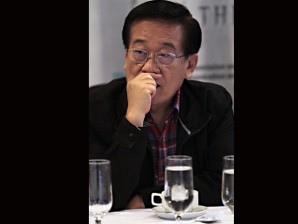MANILA, Philippines–Because it went straight to the Supreme Court without first exhausting all available remedies, the Diocese of Bacolod’s petition to block the Commission on Elections from ordering the removal of controversial political tarpaulins from the facade of the San Sebastian Cathedral in the city may not be acted upon by the high court.
Election lawyer Romulo Macalintal expressed the opinion on Sunday, saying the high court might not act on the Bacolod diocese’s petition on the grounds of prematurity or lack of jurisdiction.
The Supreme Court, however, could suspend its rules and take cognizance of the case “in the interest of justice,” and if it does, the Bacolod diocese would have a strong case against the Comelec, Macalintal said.
Explaining the prematurity of taking the case to the high court, the election lawyer said the diocese should have first filed a motion for reconsideration of the Comelec’s order to remove the tarpaulins and asked the agency’s commissioners to respond to their petition.
In the letter-order, Comelec law department head Esmeralda Ladra demanded that the diocese remove the large “Team Buhay” and “Team Patay” tarpaulins church officials had put up outside the cathedral as their sizes violated Comelec Resolution No. 9615, which allows election propaganda materials measuring at most 2 x 3 feet.
The two tarps were originally an even bigger single piece listing the names of the senatorial candidates the diocese was recommending the faithful to either vote for or reject depending on their stand on the controversial reproductive health law, which the Catholic Church in the Philippines is opposed to.
When called to account for the oversized tarp, Church officials simply cut the tarpaulin in two, but the Comelec said these still violated the rules on sizes.
Ladra warned that failure to remove the tarpaulins would prompt her office to file election offense charges against the diocese.
Macalintal reminded the protagonists that the Supreme Court could review only Comelec cases that were limited to decisions or orders issued by the Comelec en banc (all the commissioners in session).
“The court does not even have the power to review decisions of a division of the Comelec, more so an order of a mere department in the poll agency,” he said in a statement.
Still, he noted, the diocese had a “very strong case” against the Comelec if the election body insisted on the removal of the tarpaulins.
For one, the Comelec resolution does not say that a private person may not post election propaganda materials of whatever size on his property.
Macalintal said it was clear that the church property was private, contrary to the Comelec resolution that bars the display of election materials in public places.
In order to enforce the resolution, Macalintal noted that it would require the filing in the Comelec by interested persons or groups of a petition to remove prohibited campaign materials.
“For sure, the petition cannot be filed by the law department of the Comelec as the Comelec cannot be the complainant, prosecutor and judge all rolled into one,” he said.
Macalintal also said that “strictly speaking,” the tarpaulins were “not election propaganda” but “an expression of the Church’s continuing position against the reproductive health law, which the diocese wants to disseminate to its parishioners.”
He said this act of the Church was “covered by the constitutional guarantee on freedom of expression and religion, the exercise of which could only be prevented by the government if there was a clear and present danger to the nation.”
“The display of the controversial tarpaulins on private property does not endanger the life or property of anyone,” he said.
